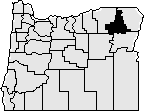
Population growth in eastern Oregon during the early 1860s prompted the Legislative Assembly to split Umatilla and Baker Counties from Wasco County on Sept. 22, 1862. Further development of the Grande Ronde Valley led to calls for the legislature to split Union County from Baker County. This finally occurred on Oct. 14, 1864. Union County's name reflects the support of the people in this area toward maintaining the United States during the Civil War.
Between 1875 and 1913, adjustments were made to Union County's borders with Baker, Umatilla, and Wallowa Counties. Union County, lying between the Blue and Wallowa Mountains, is bordered by Wallowa County on the east and north, Umatilla County on the west, and
Grant and
Baker Counties on the south.
The establishment of a county seat resulted in competition, based on geography and on economic and population growth, between La Grande and the city of Union. The county seat moved between Union and La Grande until it was permanently transferred to La Grande in 1905.
With each transfer of the county seat, there was a similar removal of the county courthouse. The first courthouses were rented structures in Union and La Grande. When the city of Union was designated as the county seat in 1874, the county's records were moved to a new brick courthouse in the area where Union High School now stands. La Grande regained the county seat in 1905 and moved into the courthouse that had been built the previous year as the city hall. The courthouse was razed in 1996 and offices for the county clerk, assessor, tax collector, and planning department were relocated to the nearby Chaplin Building. A new courthouse was constructed in 2016.
The government of Union County consisted originally of a county judge, two county commissioners, clerk, sheriff, treasurer, assessor, school superintendent and coroner. It changed from a county court to a board of commissioners in 1991.
The county historically has been a slow growth area. The first census of the county in 1870 showed only 2,552 inhabitants. It has grown steadily and by 2016 the population was 26,745, representing an increase of 3.9% since 2010.
The initial economic interest in the area was mining, but most of the mines were in the area annexed by Baker County in 1901. Over the years farming (wheat, fruit, vegetables, and grass seeds), cattle, sheep raising, and timber replaced mining as the primary economic forces in the county. Nearby mountains and streams provide hunting, fishing, skiing and camping opportunities.